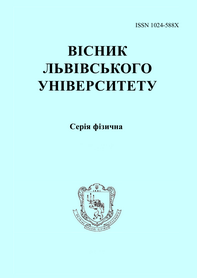DOI: https://doi.org/10.30970/vph.59.2022.23
Absorption Spectroscopy and ComputerModelling Study of the Chromophore Group Modification in(NH4)2CuCl4\times2Н2О Ferroelastoelectric
V. Kapustianyk, S. Semak, Yu. Chornii, O. Bovgyra, M. Kovalenko

| Visnyk of the Lviv University. Series Physics
59 (2022) с. 23-41
DOI: https://doi.org/10.30970/vph.59.2022.23 Absorption Spectroscopy and ComputerModelling Study of the Chromophore Group Modification in(NH4)2CuCl4\times2Н2О FerroelastoelectricV. Kapustianyk, S. Semak, Yu. Chornii, O. Bovgyra, M. Kovalenko |  |
(не менше 1800 знаків) This work was devoted to study of the chromophore group temperature modification in (NH4)2CuCl4\times2Н2О ferroelastoelectric using the experimental absorption spectroscopy and computer modelling. First of all, this information concerns the variation of the copper-halogen-hydrate complex and related structural changes around the ferroelastoelectric phase transition at \it{T}c=200.5 K. It was shown that this complex possesses the shape of a flattened octahedron with the shortest distance O-Cu-O with a simultaneous rhombic distortion within the equatorial plane. The parameters of the elementary contours corresponding to \textit{d}-\textit{d} electron transitions within Cu2+ ion were found to manifest the noticeable anomalies in their temperature dependences at the phase transition point. Observed noticeable growth of light scattering below the Curie point is considered as manifestation of the FEE domain structure which hardly can be observed by the direct methods. The \textit{ab initio} calculations on the basis of the density functional theory provided the additional information, important for the adequate identification of the absorption bands and corresponding electron transitions. The absorption spectra calculated on the basis of computer modelling were found to correlate fairly well with those obtained in the experiment.The absorption edge at the near UV region of the calculated spectrum for the light polarized along the \textit{z} axis was assigned to the electron transitions from Cu2+ \textit{d} orbitals to the \textit{s}-\textit{p} hybridized orbitals of Cl- and O2- in the bottom of the conduction band, whereas for the light polarized in the perpendicular direction it is related to the charge transfer band from Cl- \textit{p} orbitals to the \textit{d} orbitals of Cu2+. The fundamental absorption edge corresponding to the electron transitions between the valence and conductivity bands was found to be located above 50000 cm-1.